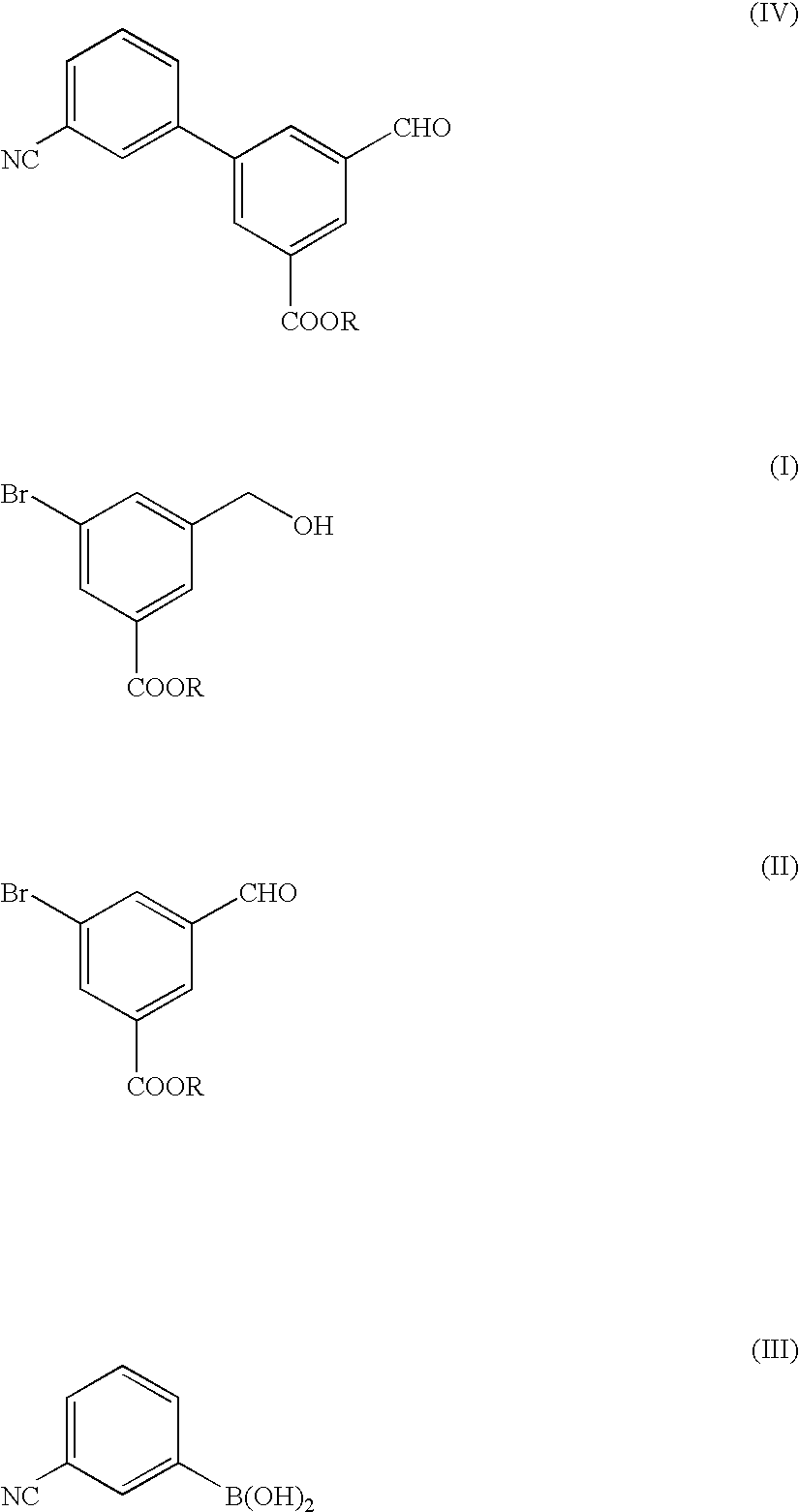Process for producing 5-(3-cyanophenyl)-3-formylbenzoic acid compound
a technology of cyanophenylbenzoic acid and compound, which is applied in the preparation of carboxylic compound, group 3/13 element organic compound, organic chemistry, etc., can solve the problems of difficult use in industrial practice, difficult control of the inhibiting effect of conventional thrombin agent against blood coagulation, and difficult low temperature reaction effect, etc., to achieve high yield, low cost, and easy procedure
- Summary
- Abstract
- Description
- Claims
- Application Information
AI Technical Summary
Benefits of technology
Problems solved by technology
Method used
Image
Examples
production example 1
Preparation and Purification of methyl 5-bromo-3-(hydroxymethyl)benzoate (the Formula (I))
A three-necked flask having a capacity of 2 liters was charged with 109.2 g of dimethyl 5-bromo-isophthalate and then with 400 ml of tetrahydrofuran (THF), to prepare a solution of dimethyl 5-bromoisophthalate. The solution was mixed with 16.6 g of sodium borohydride and the resultant mixture liquid was agitated while cooling the mixture liquid with ice pieces. Separately, 40.5 ml of methyl alcohol were dissolved in 150 ml of THF, the resultant solution was mixed in the ice-cooled mixture liquid. Then, the resultant reaction mixture liquid was agitated for 5 hours while cooling with ice pieces. The reaction mixture liquid was added with 380 ml of water to terminate the reaction, and then mixed with a 1 mole hydrochloric acid solution to adjust the pH value of the reaction mixture liquid to 7.0. The resultant reaction mixture liquid was subjected to an extraction treatment with 380 ml of ethy...
production example 2
Preparation of 3-formylphenylboronic acid (the Formula (VI)
A three-necked flask with a capacity of 2 liters was charged with 24.9 g of metallic magnesium. Separately, a solution was prepared by dissolving 215.34 g of 3-(dimethoxymethyl)bromobenzene in 1095 ml of THF.
The three-necked flask containing the magnesium metal was further charged with the THF solution in an amount of 75 ml and then with 1.07 ml of a reaction initiator consisting of 1,2-dibromoethane. When an exothermic reaction is initiated in the reaction mixture in the three-necked flask, the remaining amount of the THF solution was gradually dropped into the flask to such an extent that the reaction mixture is moderately refluxed. After the dropping procedure of the THF solution was completed, the resultant reaction mixture liquid in the flask was agitated at room temperature for one hour. A Grignard reagent consisting of a magnesium compound of 3-(dimethoxymethyl)bromobenzene was obtained.
Separately, a three-neck...
production example 3
Preparation of 3-cyanophenylboronic acid (of the Formula (III))
In a three-necked flask with a capacity 3 liters, 123.4 g of the 3-formylphenylboronic acid prepared in Production Example 2, 68.6 g of hydroxylamine hydrochloride, 1050 ml of formic acid and 112.1 g of sodium formate are placed and mixed with each other. The resultant mixture liquid was heated for 8 hours while refluxing. The resultant reaction mixture liquid was left to stand in the ambient atmosphere for one night. Thereafter, in the case where a precipitate was generated in the reaction mixture liquid, this mixture liquid was agitated while cooling with ice and, in the case where no precipitate was generated in the reaction mixture liquid, the mixture liquid was mixed with a small amount of precipitation seed particles and agitated. From the resultant reaction mixture liquid, the solid precipitate was collected, by filtration and dried. The target compound, 3-cyanophenylboronic acid was obtained in an amount of 82...
PUM
 Login to View More
Login to View More Abstract
Description
Claims
Application Information
 Login to View More
Login to View More - R&D
- Intellectual Property
- Life Sciences
- Materials
- Tech Scout
- Unparalleled Data Quality
- Higher Quality Content
- 60% Fewer Hallucinations
Browse by: Latest US Patents, China's latest patents, Technical Efficacy Thesaurus, Application Domain, Technology Topic, Popular Technical Reports.
© 2025 PatSnap. All rights reserved.Legal|Privacy policy|Modern Slavery Act Transparency Statement|Sitemap|About US| Contact US: help@patsnap.com



